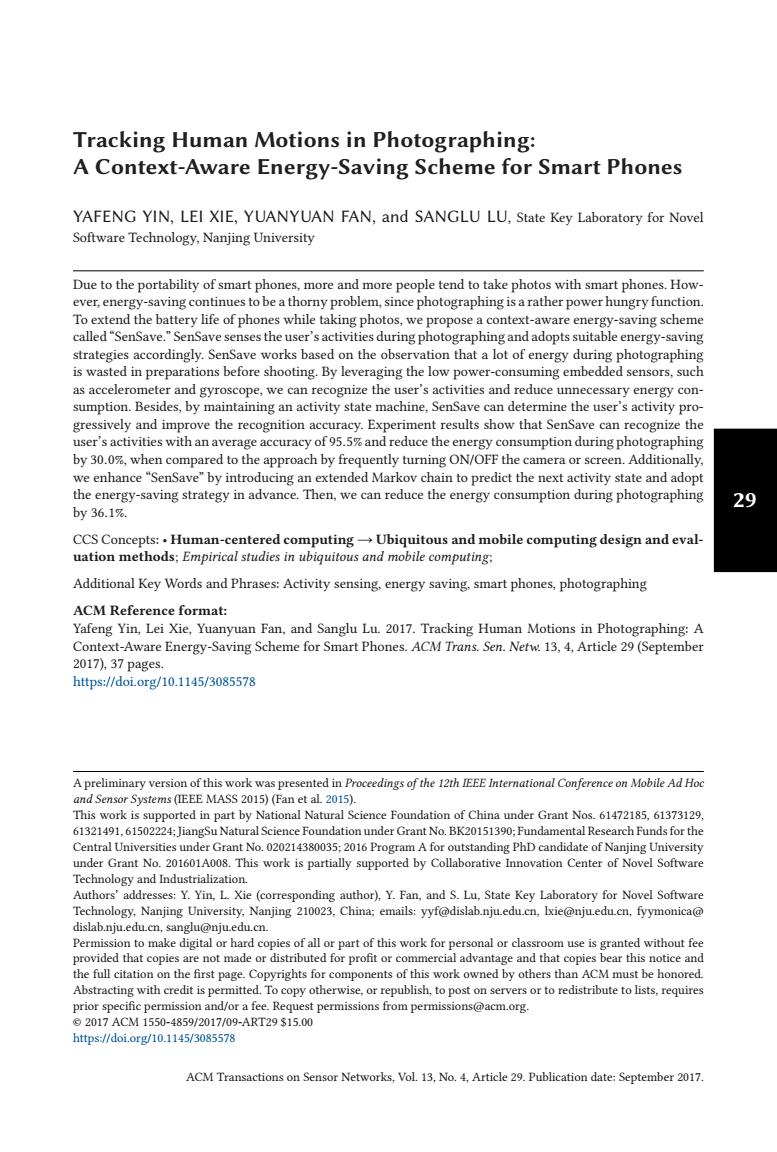正在加载图片...

Tracking Human Motions in Photographing: A Context-Aware Energy-Saving Scheme for Smart Phones YAFENG YIN,LEI XIE,YUANYUAN FAN,and SANGLU LU,State Key Laboratory for Novel Software Technology,Nanjing University Due to the portability of smart phones,more and more people tend to take photos with smart phones.How- ever,energy-saving continues to be a thorny problem,since photographing is a rather power hungry function. To extend the battery life of phones while taking photos,we propose a context-aware energy-saving scheme called"SenSave."SenSave senses the user's activities during photographing and adopts suitable energy-saving strategies accordingly.SenSave works based on the observation that a lot of energy during photographing is wasted in preparations before shooting.By leveraging the low power-consuming embedded sensors,such as accelerometer and gyroscope,we can recognize the user's activities and reduce unnecessary energy con- sumption.Besides,by maintaining an activity state machine,SenSave can determine the user's activity pro- gressively and improve the recognition accuracy.Experiment results show that SenSave can recognize the user's activities with an average accuracy of 95.5%and reduce the energy consumption during photographing by 30.0%,when compared to the approach by frequently turning ON/OFF the camera or screen.Additionally, we enhance"SenSave"by introducing an extended Markov chain to predict the next activity state and adopt the energy-saving strategy in advance.Then,we can reduce the energy consumption during photographing 2 by36.1%. CCS Concepts:Human-centered computing-Ubiquitous and mobile computing design and eval- uation methods;Empirical studies in ubiquitous and mobile computing; Additional Key Words and Phrases:Activity sensing.energy saving.smart phones,photographing ACM Reference format: Yafeng Yin,Lei Xie,Yuanyuan Fan,and Sanglu Lu.2017.Tracking Human Motions in Photographing:A Context-Aware Energy-Saving Scheme for Smart Phones.ACM Trans.Sen.Netw.13,4,Article 29(September 2017),37 pages. https:/doi.org/.10.1145/3085578 A preliminary version of this work was presented in Proceedings of the 12th IEEE International Conference on Mobile Ad Hoc and Sensor Systems (IEEE MASS 2015)(Fan et al.2015). This work is supported in part by National Natural Science Foundation of China under Grant Nos.61472185,61373129, 61321491,61502224;JiangSu Natural Science Foundation under Grant No.BK20151390:Fundamental Research Funds for the Central Universities under Grant No.020214380035;2016 Program A for outstanding PhD candidate of Nanjing University under Grant No.201601A008.This work is partially supported by Collaborative Innovation Center of Novel Software Technology and Industrialization. Authors'addresses:Y.Yin,L Xie(corresponding author),Y.Fan,and S.Lu,State Key Laboratory for Novel Software Technology,Nanjing University,Nanjing 210023,China;emails:yyf@dislab.nju.edu.cn,lxie@nju.edu.cn,fyymonica@ dislab.nju.edu.cn,sanglu@nju.edu.cn. Permission to make digital or hard copies of all or part of this work for personal or classroom use is granted without fee provided that copies are not made or distributed for profit or commercial advantage and that copies bear this notice and the full citation on the first page.Copyrights for components of this work owned by others than ACM must be honored. Abstracting with credit is permitted.To copy otherwise,or republish,to post on servers or to redistribute to lists,requires prior specific permission and/or a fee.Request permissions from permissions@acm.org. ©2017ACM1550-4859/2017/09-ART29$15.00 https:/∥doi.org/10.1145/3085578 ACM Transactions on Sensor Networks,Vol.13,No.4,Article 29.Publication date:September 2017.29 Tracking Human Motions in Photographing: A Context-Aware Energy-Saving Scheme for Smart Phones YAFENG YIN, LEI XIE, YUANYUAN FAN, and SANGLU LU, State Key Laboratory for Novel Software Technology, Nanjing University Due to the portability of smart phones, more and more people tend to take photos with smart phones. However, energy-saving continues to be a thorny problem, since photographing is a rather power hungry function. To extend the battery life of phones while taking photos, we propose a context-aware energy-saving scheme called “SenSave.” SenSave senses the user’s activities during photographing and adopts suitable energy-saving strategies accordingly. SenSave works based on the observation that a lot of energy during photographing is wasted in preparations before shooting. By leveraging the low power-consuming embedded sensors, such as accelerometer and gyroscope, we can recognize the user’s activities and reduce unnecessary energy consumption. Besides, by maintaining an activity state machine, SenSave can determine the user’s activity progressively and improve the recognition accuracy. Experiment results show that SenSave can recognize the user’s activities with an average accuracy of 95.5% and reduce the energy consumption during photographing by 30.0%, when compared to the approach by frequently turning ON/OFF the camera or screen. Additionally, we enhance “SenSave” by introducing an extended Markov chain to predict the next activity state and adopt the energy-saving strategy in advance. Then, we can reduce the energy consumption during photographing by 36.1%. CCS Concepts: • Human-centered computing → Ubiquitous and mobile computing design and evaluation methods; Empirical studies in ubiquitous and mobile computing; Additional Key Words and Phrases: Activity sensing, energy saving, smart phones, photographing ACM Reference format: Yafeng Yin, Lei Xie, Yuanyuan Fan, and Sanglu Lu. 2017. Tracking Human Motions in Photographing: A Context-Aware Energy-Saving Scheme for Smart Phones. ACM Trans. Sen. Netw. 13, 4, Article 29 (September 2017), 37 pages. https://doi.org/10.1145/3085578 A preliminary version of this work was presented in Proceedings of the 12th IEEE International Conference on Mobile Ad Hoc and Sensor Systems (IEEE MASS 2015) (Fan et al. 2015). This work is supported in part by National Natural Science Foundation of China under Grant Nos. 61472185, 61373129, 61321491, 61502224; JiangSu Natural Science Foundation under Grant No. BK20151390; Fundamental Research Funds for the Central Universities under Grant No. 020214380035; 2016 Program A for outstanding PhD candidate of Nanjing University under Grant No. 201601A008. This work is partially supported by Collaborative Innovation Center of Novel Software Technology and Industrialization. Authors’ addresses: Y. Yin, L. Xie (corresponding author), Y. Fan, and S. Lu, State Key Laboratory for Novel Software Technology, Nanjing University, Nanjing 210023, China; emails: yyf@dislab.nju.edu.cn, lxie@nju.edu.cn, fyymonica@ dislab.nju.edu.cn, sanglu@nju.edu.cn. Permission to make digital or hard copies of all or part of this work for personal or classroom use is granted without fee provided that copies are not made or distributed for profit or commercial advantage and that copies bear this notice and the full citation on the first page. Copyrights for components of this work owned by others than ACM must be honored. Abstracting with credit is permitted. To copy otherwise, or republish, to post on servers or to redistribute to lists, requires prior specific permission and/or a fee. Request permissions from permissions@acm.org. © 2017 ACM 1550-4859/2017/09-ART29 $15.00 https://doi.org/10.1145/3085578 ACM Transactions on Sensor Networks, Vol. 13, No. 4, Article 29. Publication date: September 2017